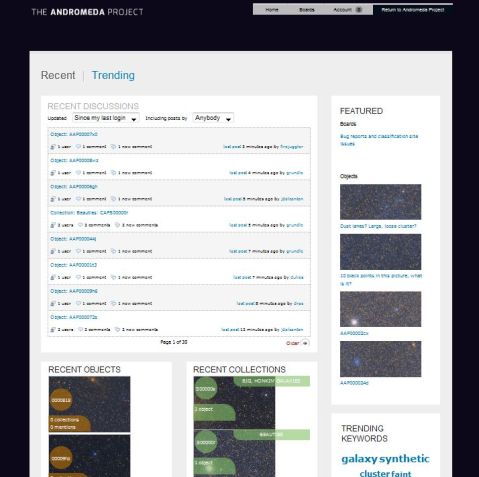Let’s Talk about Talk
We hope you are enjoying the Andromeda Project! If you find something spectacular or unexpected or have a question about the site or the science don’t keep it to yourself. We’d like the Andromeda Project community to chat and ask questions so we have provided a special discussion tool called Talk. It’s a lot like a forum but easier to find as you are given the option to chat about an object straight after you have classified it. Many of you are already making good use of Talk and it’s great to have your comments and feedback. This allows the team to fix glitches and answer your questions.
So where is Talk? When you have finished marking your image you will see the question “Would you like to discuss this image in Talk?” If you click “Yes” you will be taken to a page on Talk where you can say something about the image you just classified and also see what anyone else has said about it. You do need to be logged in, however, to post comments and make full use of Talk.
If you want to go into more detail you have the chance to start a discussion, or contribute to an existing one. You can even “watch” a discussion. Click on “watch discussion” and if anyone adds to the discussion you will receive an e-mail alert. Just make sure you have e-mail notifications enabled in your profile settings. When you’re done just click on “Return to Andromeda Project“ to resume classifying. Don’t feel you have to discuss every image but we’d really like to know about the ones you find interesting and unusual.
To help the scientists and the community keep track of what is being classified and discussed we’d like you to use hashtags (#) with a keyword to describe what you find, for example, #bright-cluster, #faint-cluster, #galaxies or #stars. In this way the community can create lists which can be searched.
You can also put objects you find into a collection. When you click “discuss this object” just click on “collect this” under the image and give your collection a name. You can see other people’s collections next to the images.
Hover your mouse over the menu at top right: “Home, Boards, Account” to see them expand. Clicking on “Home” shows you recent and featured discussions and trending keywords. You will also find a more detailed Talk tutorial in the Home menu. You can send messages to other community members using the link under “Account” and you can discuss things forum style on one of 3 Boards: Chat, Science and Help.
Chat: is where you can chat with the rest of the community. Virtual tea and coffee are always available!
Science: is a place to have general science discussions related to the Andromeda Project. The science team will look out for your questions.
Help: is your first point of call if you get stuck. This is where you can discuss the website and report any problems you’re having. The techies will keep an eye on this board.
You can also go directly to Talk from talk.andromedaproject.org
However you get there, come and Talk to us, we’re waiting!
4 responses to “Let’s Talk about Talk”
Trackbacks / Pingbacks
- - December 10, 2012


Do you want both Globulars & Galactic Disc clusters of just the Disc objects?. Of course, I realize that it may not be possible to distinguish between them at this distance.
What about those of us who do IMAGING? Is there anything we as a group can add? There IS the possibility of extended observing time, when a Professional instrument is unavailable, even if the image scale is different – but that can be corrected during processing.
Also, when I find an object that looks interesting, how do I differentiate it from something else, nearby? Do the individual images have coordinates on them for easy identifications? Also, are the individual frames numbered so that one can go back to a specific frame to say, Printout the image & do a mosaic on one’s wall, by stitching them together?
Hi Jerry,
Thanks for your note.
We do want to catalog both globular and disk/open clusters. Globulars are the most massive, oldest population of clusters, while the open clusters are the younger clusters and are frequently low mass. For us, they are just two parts of the overall distribution of clusters. And this dichotomy between disk & globular clusters doesn’t include all clusters; already from our initial cluster searching we’ve found objects with globular-like masses (~100,000 stars), but with ages of ~1 billion years, much younger than the typical globular with ages of 13 billion years.
As for your offer of imaging; the primary need for additional imaging would be time domain studies, something our survey is not optimized to do. There are other astronomers working on time domain studies of Andromeda:
http://adsabs.harvard.edu/abs/2012AJ….143…89L
and our data will be very helpful for understanding the exact properties of anything that does vary.
Finally, there are individual RA/Dec coordinates shown after each image on the large scale picture of Andromeda. If you save the object to your favorites or talk about the object, you can click on the image, then right click to “View Image” in your browser. This will open the image with the full path name. e.g.

This last name is the brick, field and subfield number of the image. From this you can explore the neighboring fields by editing the Brick/Field/Subfield numbers.
ADS link is broken (those repeated periods/full stops mess up the URL, big time)